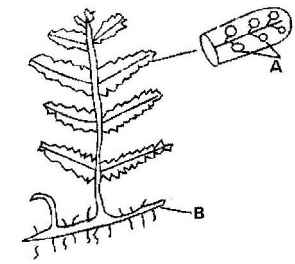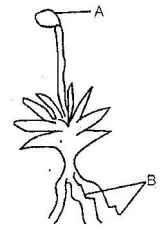Questions
- State two ways in which some fungi are harmful to man ( 2 marks)
- The diagram below represents a fern

Name- Parts labeled A and B ( 2 marks)
- The division which the plant belongs ( 1 mark)
- An organism with an exoskeleton, segmented body, two pairs of legs per segment, a pair of eyes and a pair of eyes and a pair of short antennae belongs to the phylum ( 1 mark)
- When are two organisms considered to belong to the same species? ( 2 marks)
- A student caught an animal which had the following characteristics;
- Body divided into two parts
- Simple eyes
- Eight legs
The animal belongs to the class ( 1 mark) - Below is a list of organisms, which belong to classes insecta, myriapoda and arachnida. Tick, centipede, praying mantis, tsetse fly. Millipede and spider. Place the organisms in their respective classes in the table below. Give reasons in each case.
Class Organisms Reasons Insecta Myriapoda Arachnida - State two characteristics features of members of division bryophyte (2 marks)
- State two ways in which some fungi are beneficial to humans ( 2 marks)
- Other than having many features in common state the other characteristics of species ( 1 mark)
- Beside the abdomen, name the other body part of members of arachnida (1 mark)
- Name the phylum whose members possess notochord. ( 1 mark)
- Name the class in the phylum arthropoda which has the largest number of individuals ( 1 mark)
- To which class does an animal with two body parts and four pairs of legs belong? (1 mark)
-
- Name two organisms that cause food spoilage ( 2 marks)
- Name two methods of food preservation and for each state the biological principal behind it. ( 2 marks)
-
- List two characteristics that mammals share with birds ( 2 marks)
- State two major characteristics that are unique to mammals ( 2 marks)
- What two characteristics distinguish animals in phylum chordata? ( 2 marks)
- The diagram below shows a plant

- Name the parts labeled A and B (2 marks)
- Name the division to which the plant belongs ( 1 mark)
- Which is the dominant generation of the plant in the diagram? (1 mark)
- State three characteristics of the organisms in the division named (b) above?
- What three characteristics are used to divide the arthropods into classes? (3 marks)
-
- Write two differences between algae and fungi ( 2 marks)
- Give the economic importance of algae ( 1 mark)
-
- What is alteration of generations? ( 3 marks)
- Name two divisions in plant kingdom that shows alternation of generation (2 marks)
-
- A millipede, grasshopper and crayfish all belong to phylum arthropoda.
Mention three major characteristics that they have in common. (3 marks) - The specific name of Irish potato is solanum Tuberrasum
- Identify two errors that have been made when writing the name
- What is the species name of Irish potato?
- An ecologist came across a plant with the following characteristics, green in colour, non- flowering, compound leaves and sori on the underside of the leaflets. State the probable division of the plant. ( 1 mark)
- A millipede, grasshopper and crayfish all belong to phylum arthropoda.
- An organism with an exoskeleton, segmented body, two pairs of legs per segment, a pair of eyes and a pair of short antennae belongs to the class ( 1 mark)
- List the main characteristics that are used to sub- divide arthropods into classes (2 marks
- Name the main method of reproduction among bacteria. ( 1 mark)
Answers
- - Food spoilage
- Food poisoning
- Cause disease -
- A- Sorus
B- Rhizomes - Pteridophyta
- A- Sorus
- Arthropoda
- When they interbreed freely giving rise to a viable/fertile offspring.
- Arachnida
-
Organism Reason Insecta - Praying mantis
- Tsetse fly- 3 body parts
- 3 pairs of legsMyriapoda -Centipede
-Millipede-Many segments
-Many legsArachnida -Tick
-Spider-2 body parts
-4 pairs of legs - - Presence of rhizoids
- Absence of vascular tissues
- Body parts not differentiated into roots, stem and leaves - - Brewing industry
- Baking of bread
- Manufacture of medicine/antibiotics
- Source of food
- Manufacture of vitamin K and B12 - Interbreed to produce fertile/viable offspring
- Cephalothorax; prosona.
- Chordata
- Class insecta
- Arachnida
-
- - Fungi
- Saprophytic bacteria - - Refrigeration
- Very low temperature inactivates the organism and metabolic activities are very low and they do not reproduce
- Cooking –High temperatures kill the micro-organism and they cannot reproduce
- Preservatives – create unsuitable acidic media in which micro-organisms cannot grow.
- Salting – Create high osmotic pressure and micro-organisms become dehydrated.
- - Fungi
-
- - They are closed circulatory system
- They are homoeothermic
- Both use lungs for gaseous exchange - - They have mammary glands
- Skin covered with fur or hair
- They have diaphragm separating thoracic and abdominal cavities
- - They are closed circulatory system
- - Have notochord in embryonic stage
- Have endoskeleton -
- A-Capsule B- Rhizoids
- Division Bryophyta
- Gametophyte
- - Vascular tissues absent
- Body not differentiated into roots, leaves or stem.
- Display alternation of generations.
- - Number of body parts
- Number of appendages
- Presence of wings -
- - Algae have chlorophyll but fungi do not have.
- Algae are single celled while fungi are multicellular. - - Source of food for aquatic animals
- Manufacture of gels and paints
- Source of agar used in cultivating micro-organism
- - Algae have chlorophyll but fungi do not have.
-
- The spore producing structure (asexually) gives rise to the gamete producing structure (sexual) and they alternate.
- Division bryophyta
Division pteridophyta
-
- - Segmented bodies
- Jointed appendages
- Exoskeleton
- Body divided into parts - Second name should be in small letter. The names should be underlined.
- Tuberrasum
- Division pteridophyta
- - Segmented bodies
- Class diplopoda
- - Number of body parts
- Number of legs
- Number of wings
- Number of antennae - Binary fission
Join our whatsapp group for latest updates
Tap Here to Download for 50/-
Get on WhatsApp for 50/-
Download Classification II Questions and Answers - Biology Form 3 Topical Revision.
Tap Here to Download for 50/-
Get on WhatsApp for 50/-
Why download?
- ✔ To read offline at any time.
- ✔ To Print at your convenience
- ✔ Share Easily with Friends / Students

